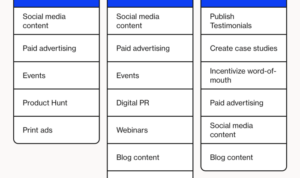Creating a Value Proposition Statement sets the stage for this enthralling narrative, offering readers a glimpse into a story that is rich in detail with american high school hip style and brimming with originality from the outset.
Crafting a compelling pitch that captures the essence of your business in a unique and memorable way is crucial in today’s competitive market. Let’s dive into the art of creating a value proposition statement that will make your brand stand out.
Understanding Value Proposition Statement

A value proposition statement is a clear, concise statement that explains the benefit that a product or service provides to customers. It Artikels what sets a business apart from its competitors and why customers should choose it over others.
Importance of a Value Proposition Statement
A value proposition statement is crucial for a business as it helps communicate the unique value that the business offers to its target audience. It sets expectations for customers and guides marketing strategies to effectively reach and engage with them.
Key Components of a Value Proposition Statement
- Unique Selling Proposition (USP): Clearly define what makes the product or service different from competitors.
- Benefits: Highlight the specific benefits or solutions that the product or service provides to customers.
- Target Audience: Identify the specific audience or market segment that the value proposition is tailored for.
Examples of Successful Value Proposition Statements
1. Apple: “Think different.” – This value proposition statement emphasizes innovation and creativity, appealing to customers who seek cutting-edge technology products.
2. Nike: “Just do it.” – Nike’s value proposition encourages customers to take action and pursue their goals, resonating with athletes and fitness enthusiasts.
Crafting a Compelling Value Proposition Statement: Creating A Value Proposition Statement

When it comes to creating a value proposition statement, it’s essential to focus on what sets your product or service apart from the competition. This statement should clearly communicate the benefits and value you offer to your target customers in a concise and compelling manner.
Tips for Making a Value Proposition Statement Unique and Memorable
A unique and memorable value proposition statement can help your brand stand out in a crowded market. Here are some tips to craft one:
- Highlight your unique selling points that differentiate your product or service from competitors.
- Use clear and simple language that resonates with your target audience.
- Create a statement that addresses the specific needs and pain points of your customers.
- Focus on the value and benefits your product or service provides, rather than just its features.
Tailoring a Value Proposition Statement to Different Customer Segments
It’s crucial to customize your value proposition statement to different customer segments to ensure relevance and effectiveness. Here’s how you can tailor it:
- Understand the specific needs and preferences of each customer segment.
- Highlight the benefits that are most appealing to each segment.
- Use language and messaging that resonates with the unique characteristics of each segment.
Examples of Effective Value Proposition Statements
Here are some examples of compelling value proposition statements tailored for specific audiences:
| Customer Segment | Value Proposition Statement |
|---|---|
| Busy Professionals |
|
| Health Enthusiasts |
|
| Small Business Owners |
|
Communicating the Value Proposition Statement
When it comes to communicating a value proposition statement, companies have a variety of channels at their disposal to reach their target audience. Whether it’s through digital marketing, social media, print ads, or even face-to-face interactions, the key is to ensure consistency in conveying the value proposition across all touchpoints.
Exploring Different Channels, Creating a Value Proposition Statement
- Website: Make sure the value proposition is prominently displayed on the homepage.
- Social Media: Utilize platforms like Facebook, Instagram, and LinkedIn to share the value proposition with a broader audience.
- Email Marketing: Include the value proposition in email campaigns to keep customers engaged.
- Advertising: Incorporate the value proposition into print ads, online banners, and other advertising materials.
Importance of Consistency
Consistency is key when it comes to conveying the value proposition. By ensuring that the message remains the same across all touchpoints, companies can build trust and credibility with their audience.
Integrating Value Proposition into Marketing Materials
- Taglines: Create a catchy tagline that encapsulates the value proposition and use it consistently across all marketing materials.
- Visuals: Use images and graphics that reinforce the value proposition and resonate with the target audience.
- Content: Incorporate the value proposition into blog posts, product descriptions, and other written content to reinforce the message.
Examples of Effective Communication
- Apple: Known for its “Think Different” campaign, Apple effectively communicates its value proposition of innovation and creativity through all its marketing channels.
- Nike: With the tagline “Just Do It,” Nike conveys a message of empowerment and motivation consistently across its marketing materials.
- Amazon: Amazon’s focus on customer convenience and fast delivery is evident in its marketing messaging, ensuring a seamless experience for consumers.
Evaluating and Iterating on the Value Proposition Statement
Once you have crafted a value proposition statement, it is crucial to evaluate its effectiveness to ensure it resonates with your target audience. Testing and measuring the statement’s impact can provide valuable insights for refining and optimizing it for better results.
Importance of Testing and Measuring
Testing and measuring the effectiveness of a value proposition statement allows you to understand how well it is performing in the market. By collecting data and feedback, you can identify areas of improvement and make informed decisions to enhance the statement’s impact.
- Conduct A/B testing to compare different versions of the value proposition and see which one performs better.
- Use analytics tools to track metrics like conversion rates, click-through rates, and customer engagement to gauge the statement’s effectiveness.
- Solicit feedback from customers, stakeholders, and team members to gather diverse perspectives on the value proposition.
Strategies for Collecting Feedback
Collecting feedback on the value proposition statement is essential to understand how it is perceived by the target audience and stakeholders. Here are some strategies to gather valuable feedback:
- Conduct surveys and interviews with customers to gather their opinions and suggestions on the value proposition.
- Organize focus groups to facilitate in-depth discussions and gather qualitative feedback on the statement.
- Monitor social media channels and online reviews to see how customers are reacting to the value proposition.
Iterating and Refining the Value Proposition Statement
Iterating and refining the value proposition statement based on feedback and data is a continuous process to ensure its relevance and effectiveness. Here are some methods to refine the statement:
- Identify key pain points and benefits that resonate with the target audience and highlight them in the value proposition.
- Test different messaging strategies and value propositions to see which one generates the best response from customers.
- Update the value proposition based on market trends, customer feedback, and competitive analysis to stay relevant and competitive.
Examples of Companies Evolving Value Proposition Statements
Several companies have successfully evolved their value proposition statements over time to better align with changing market dynamics and customer needs. Some examples include:
Amazon: Initially focused on selling books online, Amazon evolved its value proposition to become the “Everything Store,” offering a wide range of products and services to cater to diverse customer needs.
Apple: Apple’s value proposition has evolved from “Think Different” to highlighting innovation, design, and user experience as core pillars of its brand, resonating with tech-savvy consumers.
Netflix: Netflix started as a DVD rental service but transformed its value proposition to become a leading streaming platform, emphasizing personalized recommendations and original content to attract and retain subscribers.





